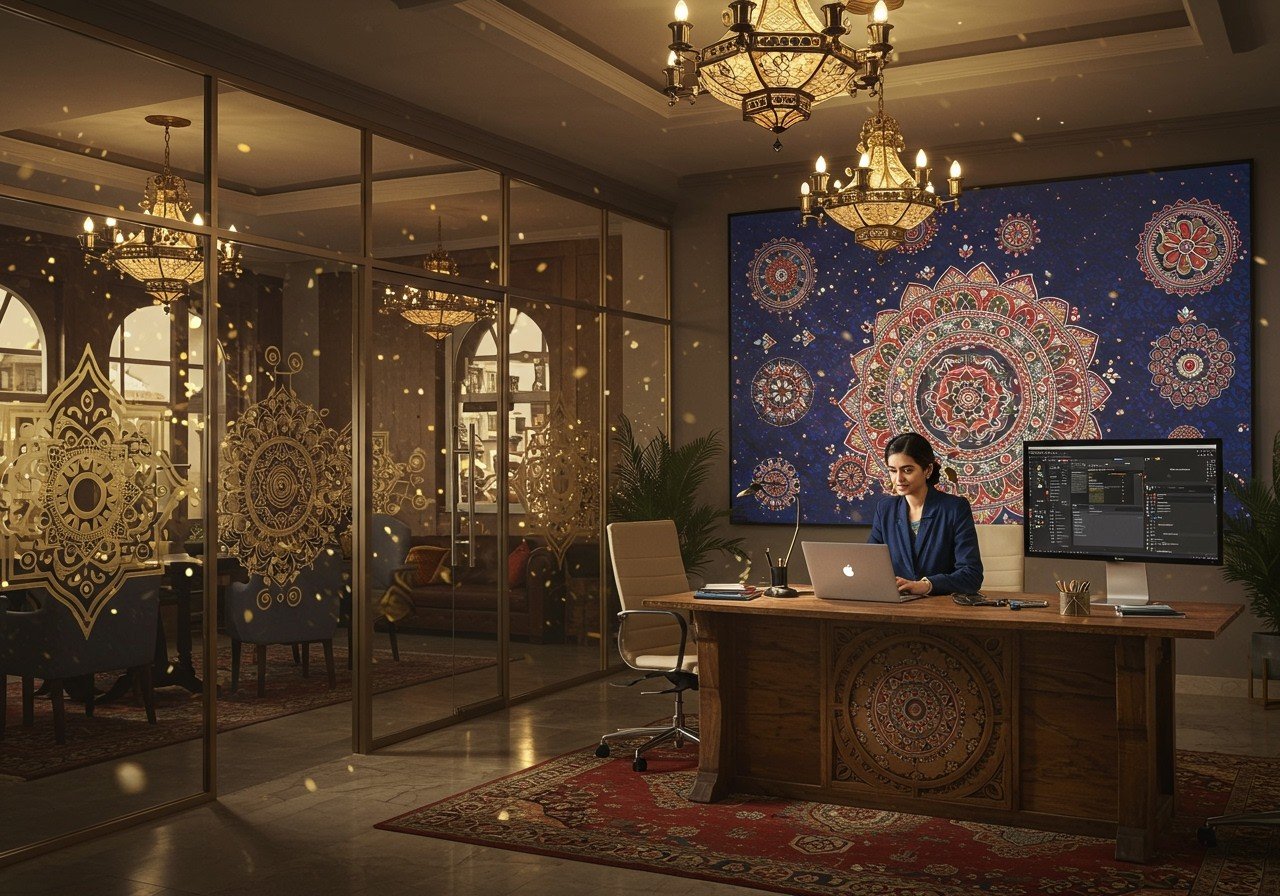
Indian design is a vibrant expression of our rich heritage, seamlessly blending history, culture, and spirituality. It resonates deeply with those who value tradition while embracing the convenience of modern life. Let’s delve into this captivating world.
A Historical Tapestry
Indian design’s journey begins over 2,500 years ago with the Indus Valley Civilization, showcasing planned cities like Harappa and Mohenjo-Daro. The influence of spirituality is evident in ancient stupas and rock-cut temples, exemplified by the breathtaking Ajanta and Ellora caves. The medieval period saw the rise of Indo-Islamic architecture, a beautiful fusion of styles seen in iconic structures like the Taj Mahal. The British colonial era introduced European influences, while post-independence India saw the rise of modernism, with Le Corbusier’s Chandigarh leaving a lasting impact.
Key Elements: A Symphony of Colors and Textures
Indian design is characterized by its vibrant colors – reds, oranges, yellows, and deep blues – each carrying symbolic meaning and creating a warm, inviting atmosphere. Intricate patterns and traditional motifs adorn rich textiles like silk, adding a touch of elegance and artistry. Natural materials like wood and stone enhance authenticity, while sturdy furniture pieces offer both functionality and aesthetic appeal. The use of fragrant scents adds another layer to the sensory experience, creating a truly immersive atmosphere. Traditional craftsmanship is highly valued, reflecting a deep respect for artistry passed down through generations. Spiritual elements like mandalas add a sense of balance and harmony.
Regional Variations: A Kaleidoscope of Styles
India’s vastness and diversity translate into a rich tapestry of regional design variations. From the intricate woodwork of Rajasthan to the terracotta artistry of Bengal, each region has its unique style shaped by climate, culture, and historical influences. These regional nuances add to the overall richness and depth of Indian design.
Influences: A Confluence of Cultures
Indian design has been shaped by a confluence of religious and cultural influences, from Hinduism and Buddhism to Jainism, Sikhism, and Islam. Influences from Central Asia, Iran, and Europe have also enriched the design landscape, creating a unique blend of styles.
Modern Trends: Embracing Contemporary Sensibilities
Modern Indian design embraces global trends while staying true to its cultural roots. There’s a growing focus on sustainability, using locally sourced materials and supporting local artisans. Clean lines, neutral colors, and practical layouts are increasingly popular, reflecting modern lifestyles. Minimalism and Maximalism, seemingly opposing styles, find their place in contemporary Indian design, showcasing its versatility and adaptability.
Inspiration: Drawing from a Rich Heritage
Indian design draws inspiration from a multitude of sources, including Hindu and Buddhist temples, ancient cave paintings, and regional aesthetics. This rich heritage provides a constant source of creativity, allowing for fresh interpretations of traditional elements in contemporary designs. Celebrating festivals like Ram Navami can also be a source of inspiration, connecting us to our roots and reminding us of the beauty of traditional practices.
Poojn.in: Your Gateway to Authentic Indian Design
Poojn.in offers a curated selection of authentic items that help you incorporate traditional Indian aesthetics into your home. For a touch of spirituality, consider the Adiyogi Marble Dust Murti (₹379). For practical and aesthetic storage, the 15-inch Bamboo Chalon is a versatile choice, perfect for displaying puja items, organizing materials, serving prasad, or creating decorative arrangements. Explore our range of flammables and decoratives to enhance your space with traditional charm. For assistance, reach us at 03369029784 or WhatsApp us at 9476142738.
Conclusion: A Timeless Legacy
Indian aesthetics represent a timeless legacy, blending the wisdom of the past with the dynamism of the present. It’s a journey of discovery, connecting us to our roots while inspiring us to create spaces that reflect our unique identities. As you explore the world of Indian design, you’ll find endless possibilities to create a home that resonates with beauty, harmony, and cultural richness.
FAQs: Your Questions Answered
What defines Indian architectural aesthetics? Indian architectural aesthetics are characterized by the incorporation of traditional elements, such as intricate carvings, arches, jalis (latticed screens), and the use of natural materials. These elements often reflect regional styles and cultural influences, creating a unique visual language.
How is Indian aesthetics applied in the decor industry? The Indian decor industry draws heavily from traditional motifs, vibrant colors, and handcrafted techniques, producing a wide range of items from textiles and pottery to furniture and wall hangings. This focus on craftsmanship and cultural heritage brings a distinct character to Indian decor.
Where can I find examples of Indian aesthetics in drawings? Traditional art forms like Madhubani, Warli, and Pattachitra paintings offer stunning examples of Indian aesthetics in drawings. These styles showcase intricate patterns, vibrant colors, and storytelling elements inspired by mythology, nature, and daily life.
What is the significance of Indian aesthetics in modern design? Indian aesthetics play a vital role in contemporary design by infusing spaces with cultural richness and authenticity. By incorporating traditional elements, designers can create spaces that are both visually appealing and deeply meaningful, bridging the gap between the past and present. For more inspiration on incorporating traditional elements into modern living, you can explore resources like this blog post on Sattvic diets.
How can I incorporate Indian aesthetics into a modern home? Blending traditional elements with contemporary design can create a harmonious and unique space. Consider incorporating jali work, ethnic textiles, handcrafted decor, and natural materials like wood and stone. Balance these elements with clean lines and modern furniture to achieve a cohesive look. You can even incorporate elements like handcrafted wooden masks for a touch of tradition and artistry.
What are the advantages of using Indian aesthetics in interior design? Indian aesthetics infuse warmth, color, and cultural significance into interior spaces. They create a connection to Indian heritage and offer a vast range of design possibilities, allowing you to personalize your space with unique and meaningful elements. You can find a variety of holy books and holy clothing at Poojn.in to enhance the spiritual atmosphere of your home.
How do Indian aesthetics influence global design trends? Indian aesthetics, with their vibrant colors, intricate patterns, and handcrafted techniques, have a significant impact on global design trends. These elements add depth, character, and a touch of exotic charm to international design styles, inspiring designers around the world. Learn more about finding inspiration in unexpected places in this blog post.


